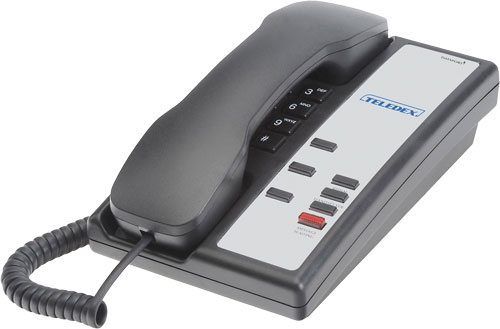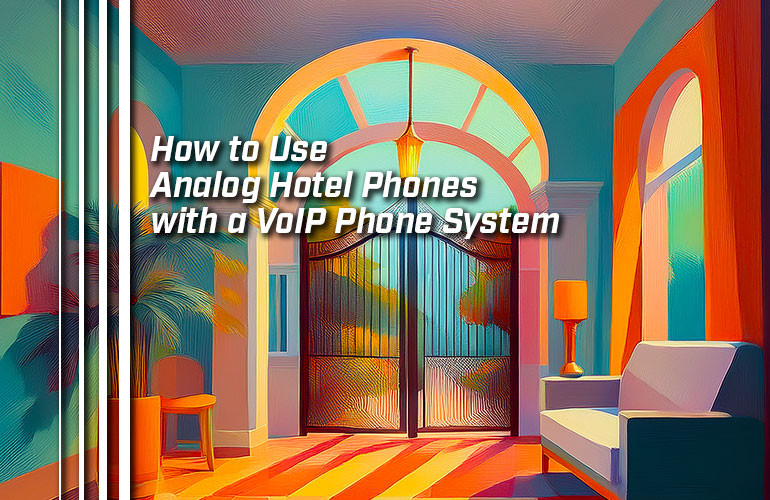We’re all trying to find ways to save money right now. But you can’t compromise the quality of your business’s communications when tightening your belt.
In this blog and in our expert buyer’s guides, we’ve covered the advantages of VoIP phone systems over analog phone systems: centralized control, simpler management, expanded features, and much more. Check out our VoIP Phone Systems Buyer’s Guide for more information.
The hospitality industry is one sector where VoIP can be a serious boon, because each room requires a phone. VoIP provides centralized fleet management and allows you to integrate your phones directly with your PMS (Property Management System).
What happens, in this economy, if you already have analog hotel phones for every room and you want to migrate to VoIP?
Don’t replace when you can reuse. Use a VoIP gateway.
In this blog, we cover how to integrate analog hotel phones into a VoIP phone system.
Let’s get into it!

TeleMatrix 9700MWD Black
VoIP Gateways for Analog Hotel Phones
To integrate analog hotel phones into a VoIP phone system, you need an adapter that translates an analog phone signal into a VoIP phone signal. This adapter is called a VoIP gateway or ATA (analog telephone adapter).
There’s no real difference between a VoIP gateway and an ATA. ATAs tend to have only one or two ports and gateways tend to have more ports than that. The actual function they serve is identical: translating an analog signal into a VoIP signal.
If you’d like a more in-depth description of this process, check out our blog, “Integration Through Translation with Gateways, ATAs, and Telephony Cards.”
When using a VoIP adapter, you need to be aware of two port types: FXS and FXO. In a nutshell, the difference is this: FXS ports connect to endpoints while FXO ports connect to the PSTN. For connecting phones, look for FXS ports. All you need to do is plug the analog phone’s cord into the FXS port on the gateway to connect it.
After the phones are connected, the port is treated basically as a VoIP endpoint by the VoIP phone system. The phone itself isn’t directly accessed by the phone system: it’s sending data like phone calls to and from a given port. The signals will be translated between VoIP and analog by the gateway.
You get all the features that an analog hotel phone already offers, plus you get the centralized control and system integration of VoIP.
So instead of replacing all your existing phones that are working just fine, you can continue to use them while migrating to an improved, modern VoIP phone system.
But there are limitations when compared with using a VoIP hotel phone. A VoIP phone is a computer, like a smartphone or a tablet. An analog phone is not a computer, so it can’t do everything a VoIP phone would be able to do.
One final note: compatibility. With VoIP, compatibility is always a key consideration. Check to ensure that your gateway is compatible with your VoIP phone system, whether that’s an on-premise VoIP phone system or a cloud-based phone service.
We mentioned in our introduction that you’ll be able to integrate your analog phones into your PMS. This also depends on compatibility between your PMS and VoIP phone system.

Teledex Nugget 3 Black
Using VoIP Gateways with New Hotel Phones
We have focused on how gateways can extend the lifetime of existing analog hotel phones. But what if you need new phones? What if you’re outfitting a new hotel?
Using a VoIP gateway, you can set up a new VoIP hotel phone system using new analog hotel phones. Analog hotel phones are typically less expensive than VoIP hotel phones, which is, well, a good thing.
So outfitting a new hotel with new analog phones is still a common choice for many businesses.
That’s why, even though our name is IP Phone Warehouse, we still sell analog hotel phones from leading manufacturers:
Of course, you have to balance the price of the analog phones themselves with the price of installing the dedicated phone wiring and equipment and the potential time cost and feature deprivation that might arise from not using VoIP.
But you can integrate new analog phones into a VoIP phone system as easily as old ones.
You can even use an ATA close to the hotel phone, then run Ethernet cable to connect the adapter to the network, so you don’t need to worry so much about telephony wiring.
There are many ways to build out a hotel phone system that works beautifully for your customers — and your budget.

